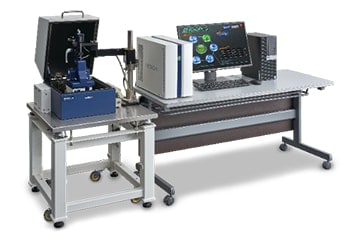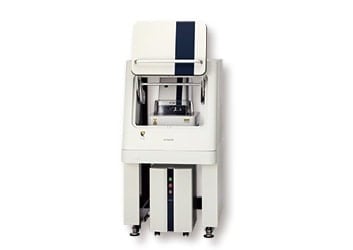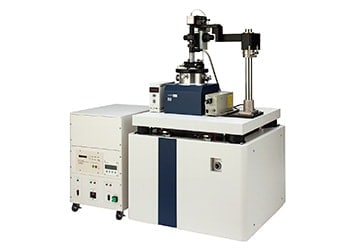View according to field: AFM for new materials development (Polymers)

Hitachi AFM will prove useful at any stage
By field
Environmental control that serves a diverse variety of needs
Polymers are used not only in traditional science and textiles, but are also increasingly utilized in the medical and electronics fields, making them a market that is expanding in scale. As daily research into polymers leads to increased technological innovation, AFMs are widely used and provide a foundation for new polymer applications. The AFM5500MⅡ responds to the increasingly diverse measurement needs that have accompanied the expansion of polymer applications, enabling stable measurement of surface topography and distribution of elastic modulus in a wide variety of environments.
Stable and accurate measurements during sample heating and cooling
Applicable products:
Since it can also measure in vacuum environments, this model is capable of stable measurement during heating and cooling. Unlike atmospheric heating, thermal oxidation does not impact surface topography or the convection of atmospheric gas. This enables stable measurement during heating or cooling over a full temperature range from -120 to +800 degrees (measurement up to +300).
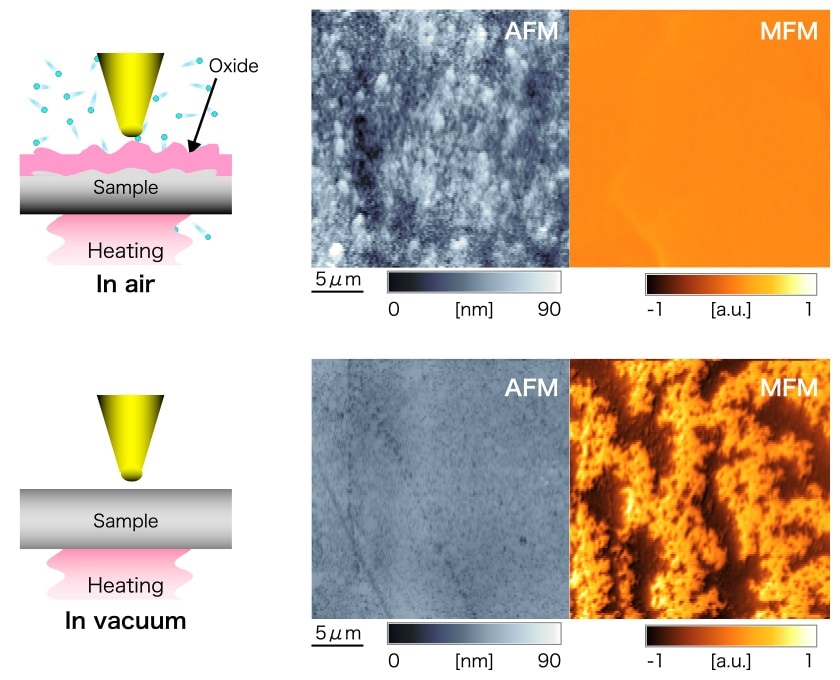
Actual case of heated measurement of a neodymium magnet with MFM in ambient and vacuum environments
Quantitative measurements of elastic modulus
Applicable products:
By employing an environmental control unit, this model can perform quantitative measurement of the elastic modulus in heated and chilled environments, or those where temperature/gas is controlled.
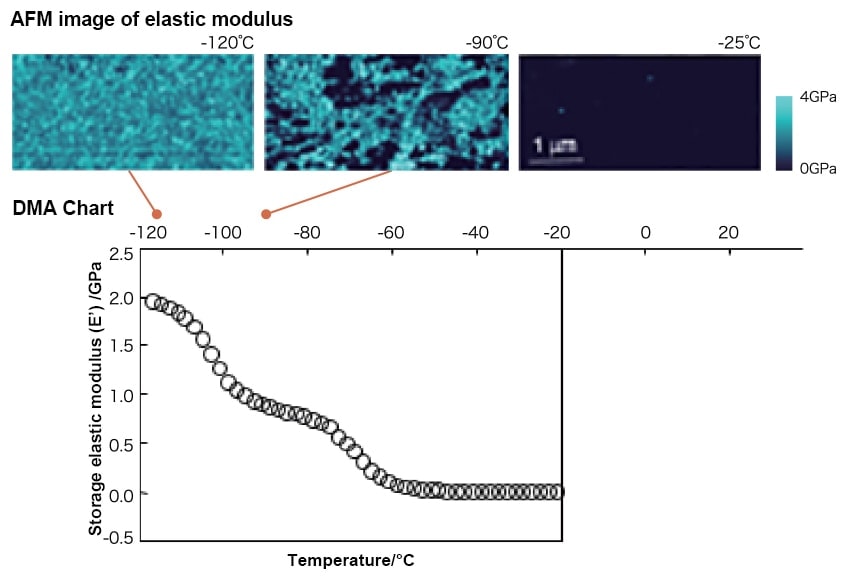
Actual case of elastic modulus mapping performed on rubber blends in a chilled environment
Humidity control / observations in liquid
In addition to the previously mentioned ambient, high-vacuum, heated and chilled environments, the environmentally controlled atomic force microscope AFM5300E also includes options applicable to measurement during inert gas replacement, humidity control and liquid submersion. Figure 6-1 illustrates the capabilities of these environmental control options by showing the results of AFM observation of electrolyte membrane fuel cells in low humidity (10%), high humidity (80%) and pure water environments. When humidity is high, you can see how the electrolyte membranes absorb water and swell to a larger size. In pure water, this swelling is even more pronounced, and we see a shift to rough surfaces.*
* Application to fuel cells: Observation of electrolyte membranes in humidity controlled and pure water environments (AFM Application Brief No. 59)
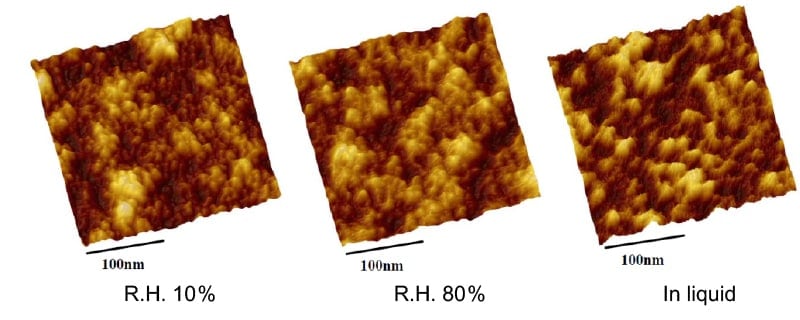
AFM observation of electrolyte membrane fuel cells in low-humidity/high-humidity/liquid environments
Observations of structural changes in a vacuum
In some polymer materials, volatile components such as low molecular weight components and residual solvents are sublimated or vaporized from the surface, leading to changes in material surface structure or composition. Figure 8-1 shows structural changes observed with AFM in film-shaped polymer materials before and after approx. 30 minutes of evacuation. After evacuation, we see the emergence of surface roughness with undulations multiple nm in height.*
* Observation of structural changes occurring within film-shaped polymer materials in a vacuum environment (AFM Application Brief No. 41)
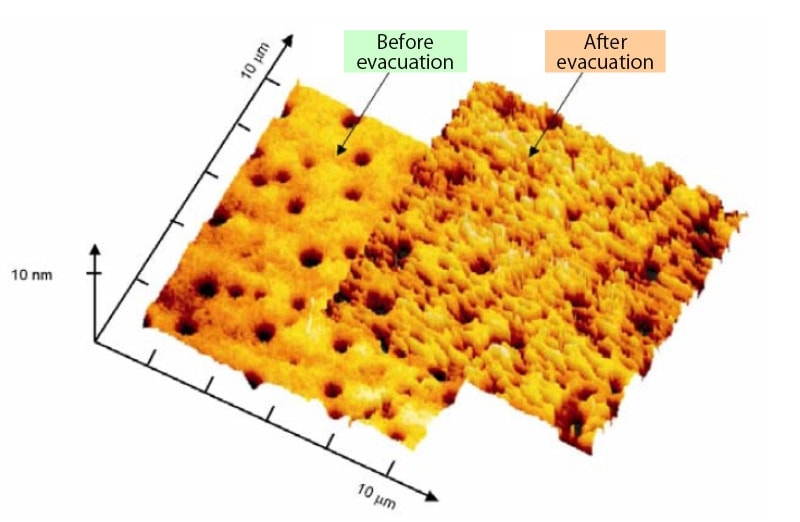
Structural changes occurring within film-shaped polymer materials in a vacuum environment
Enabled true observations of topography and other physical properties
Applicable products:
Simultaneous mapping of multiple functions with SIS-ACCESS
In addition to AFM topographic images, SIS-ACCESS can simultaneously capture various physical properties [deflection, topography derivation (edge emphasis), hardness, adhesion force, deformation, dissipation), electrical current or LM-FFM (Lateral Modulation Friction Force)]. Via the newly developed SIS Mode, it is also possible to choose weak force options with lower contact load than traditional methods, even as low as 1/10 the load of a traditional contact AFM.
Features
- Equipped with SIS mode that contains a new algorithm enabling low force options
- Enables simultaneous capture of AFM topography and various physical properties [deflection, topography derivation (edge emphasis), hardness, adhesion force, deformation, dissipation), electrical current or LM-FFM (Lateral Modulation Friction Force)]
- Equipped with simultaneous capture and display functions over a maximum of 8 channels
Comparison of conventional AFM and SIS-ACCESS
·Conventional AFM:Lateral force works constantly and the probe pushes against soft sample surfaces, making capture of true sample surface information difficult. In the image on the right, observation reveals deformation of the soft domain portion as depressions.
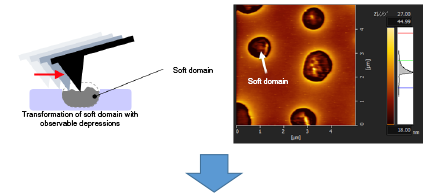
·SIS-ACCESS:Lateral movement and vertical movement take place in an area completely isolated from (above) the sample, preventing the probe from pushing into the sample due to lateral force. In the image on the right, observation reveals that deformation of the soft domain portion is suppressed and it is preserved in a state close to its original topography.
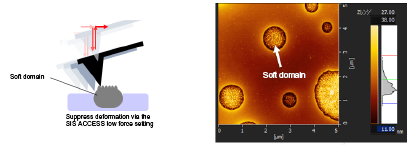
Applications
·Various physical properties of the polymer blends: From left, we see images of dissipation, deformation, adhesion, hardness, shape derivation (edge emphasis), and topography

This product is an optional product compatible with the company’s AFM5000II controller.
SIS is the name for the “Sampling Intelligent Scan” function developed by Hitachi. With SIS, the probe tip only makes contact with the sample at the time of data acquisition, and at other times it avoids the sample by moving on a plane above it in a horizontal direction at a higher speed compared to traditional methods. When it seems poised to make contact with the sample, scan speed is automatically reduced and the probe rises to avoid the sample surface.
Footnote 1: Obtains images that are closer to true topography than those taken with traditional methods.
Enabled quantitative measurements during sample heating and cooling
Applicable products:
Elastic modulus options - SIS-QuantiMech
SIS-QuantiMech transforms the load of each focus curve into an indentation volume curve and enables calculation of Young's modulus by approximating each contact model. In addition, the newly developed SIS-ACCESS function and standard equipped navigation function make several tasks intuitive and enable capture of topographic images and quantitative mechanical property evaluation to be performed simultaneously.
Features
- Simultaneously captures quantitative physical and topographic images
- Three types of quantitative imaging functions (elastic modulus, adhesion force, sample deformation)
- Compatible with each variety of contact theory model (Hertz, DMT, JKR 2-point method)
- Measurement of spring constant can be conducted by selecting between the thermal method and the size measurement method that involves calculation via image recognition from optical microscope images
- By employing an environmental control unit, this model can perform quantitative measurement of the elastic modulus in heated and chilled environments, or those where temperature/gas is controlled
Elastic modulus mapping performed on rubber blends in a chilled environment
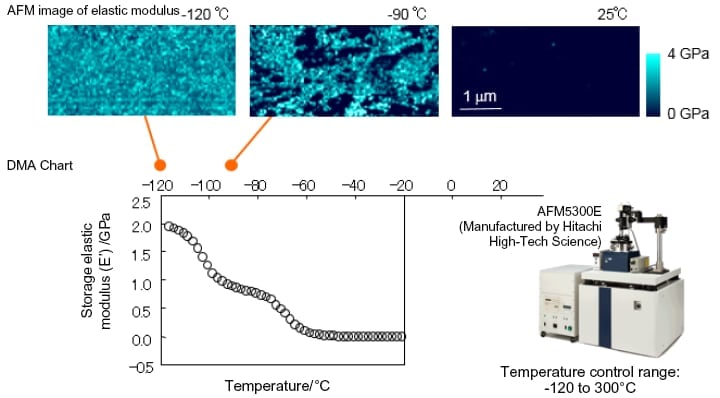
DMA and AFM measurement of the elastic modulus of gel
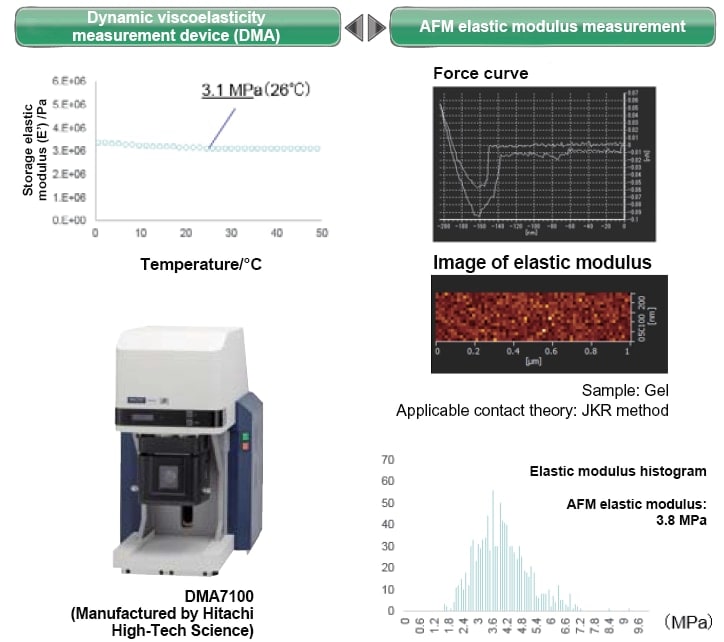
This product is an optional model compatible with Hitachi’s AFM5000II controller. Use of the product requires separate SIS-ACCESS.
SIS is the name for the “Sampling Intelligent Scan” function developed by Hitachi. With SIS, the probe tip only makes contact with the sample at the time of data acquisition, and at other times it avoids the sample by moving on a plane above it in a horizontal direction at a higher speed compared to traditional methods. When it seems poised to make contact with the sample, scan speed is automatically reduced and the probe rises to avoid the sample surface.
Product lineup
Hitachi AFM will prove useful at any stage
By application
Automation / Ease of use
High accuracy / High resolution
- High-accuracy measurements of slanted surfaces with a steep slope
- High-accuracy measurements without damaging samples
- High-resolution measurements in a vacuum
- Stable and accurate measurements during sample heating and cooling
- High-accuracy topography measurements
- High-sensitivity MFM measurements in ambient or vacuum environments
- Humidity control / observations in liquid
Physical property measurements /
Environmental Controls
- Measurements of work functions in ambient or vacuum environments
- Observations of dopant distribution
- Quantitative measurements of elastic modulus
- Observations of structural changes in a vacuum
- Enabled true observations of topography and other physical properties
- Enabled quantitative measurements during sample heating and cooling
This section introduces applications (actual measurement cases) for scanning probe microscopes (SPM/AFM).
Information for product users
This section offers information aimed at customers who use our scanning probe microscopes.
For first-time users
Related topics

“S.I.navi” is Hitachi Membership Site for analytical instruments users.
“S.I.navi” provides helpful information for daily analysis.

